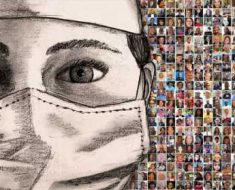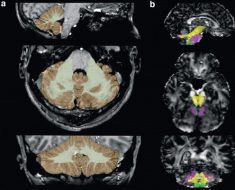Josie Granner, a doctoral candidate at the University of Michigan School of Nursing, studies the childbearing year for new parents who are survivors of trauma and post-traumatic stress.
Granner recently co-authored a study with Julia Seng, professor of nursing, that uses theories of post-traumatic stress disorder to help educate perinatal clinicians on how to address trauma in their patients. Here, she discusses pregnancy trauma exposure, who’s at risk and why it’s so important to bonding with your baby to recognize pregnancy trauma.
Who is most at risk for pregnancy trauma exposure?
People who experience trauma earlier in life are more likely to experience trauma during pregnancy. Trauma exposures that are especially salient to the childbearing year include childhood maltreatment or adverse childhood experiences, previous traumatic birth or loss, prior medical or sexual trauma and discriminatory or inequitable care. In addition, rates of PTSD are more than three times higher in lower resource, urban settings where the population is predominantly Black, than in the general female population.
The additional toll of trauma from historic human rights violations, current discrimination, microaggressions, othering and minority stress likely adds to the cumulative trauma burden experienced by marginalized groups. Race-based structural inequities in access to care and safety mean that many minority patients from marginalized groups may also have fewer resources with which to address their trauma-related needs.
How can trauma impact patients during pregnancy, childbirth and after?
The childbearing year can be difficult for trauma survivors, especially if the trauma was perpetrated by another person, as in abuse, neglect, sexual assault, household dysfunction, etc. PTSD is the most prominent long-term result of trauma, though it’s common for survivors of trauma to also experience depression and anxiety.
Many trauma survivors aren’t diagnosed with those mental health conditions, but their trauma may still affect them. Pregnancy, childbirth and early parenting can be a time when post-traumatic symptoms actually get worse. That’s because the childbearing year has so many triggers or reminders of past trauma that make a person feel like the trauma is happening again. Other trauma survivors don’t experience any post-traumatic reactions, but still use the time in pregnancy to think about how they want to parent differently than they were raised and keep their child safe.
One example of a trigger during pregnancy is when the positioning and process of vaginal exams reminds a person of a sexual assault. Another common example is when pregnant trauma survivors perceive their healthcare providers as dismissive, pressuring, or uncaring. That can remind them of feelings of vulnerability and helplessness they had as a child.
When past trauma was sexual or if it was perpetrated by a caregiver, memories and feelings from those experiences can come up again during pregnancy, birth and early parenting.
Do most patients realize that previous trauma could impact their childbirth experience?
No, for a couple of reasons. First, every trauma survivor is at a different place in their recovery. A 20-year-old pregnant woman who survived rape in college hasn’t had much time to process the incident. Those who are new in their recovery journey don't always have the words or the frameworks to explain, even to themselves, how their trauma affects them.
In contrast, other survivors may feel they’ve worked through their trauma. While that can be the case, many people’s PTSD actually gets worse in the childbearing year, even if it didn’t impact them before.
A third reason is that one of the characteristics of PTSD is avoidance. Many survivors of trauma distance themselves from the emotions associated with a traumatic event, such as fear, helplessness, shame, anger or guilt, and seek to avoid reminders that could trigger those emotions.
Can trauma survivors be retraumatized during this time, and can this impact parenting?
Absolutely. Common triggers in perinatal care include unwelcome touch or body positioning, feelings of fear or dread, dynamics of vulnerability, being disrespected and not being in control. During childbirth, some people respond to these triggers by dissociating, where thoughts, feelings, memories, sense of the world or sense of self are disconnected. Some describe this as out-of-body experience. To others it can feel like what’s happening isn’t real, like watching a movie or a play.
Those who respond to triggers by dissociating are more likely to have PTSD after the birth, postpartum depression and impaired bonding with their baby. That’s why it’s so important to discuss how trauma affects the childbearing year, so survivors get necessary support.
Everyone gets exhausted and overwhelmed after childbirth, but some experience postpartum depression or PTSD that really upends their life. These can make bonding with a baby more difficult. In the first year or so of life, bonding between caregivers and infants is critical, and imparied bonding can negatively impact a child throughout life.
It sounds like many people don’t realize they’ve experienced trauma and don’t understand the negative feelings around what is supposed to be an incredibly positive event. How might trauma manifest itself in these patients?
Experiences of trauma, how it affects people and how that manifests during the childbearing year is very nearly unique to the individual experiencing it. However, there are some helpful frameworks to help us make sense of post-traumatic stress. One way to think about it is that people have a couple of different systems that become activated in different circumstances. One system helps them go through daily life, when they don't feel threatened. The process of labor and delivery works best if this system is active, because some of the same hormones, like oxytocin, are involved.
Another system gets activated when people feel threatened. That can cause them to have a ‘fight or flight’ reaction, where they feel a rush of energy to their muscles, their blood pressure, pulse and rate of breathing go up, and they might feel afraid, anxious or angry. Another reaction that can happen when people feel threatened is ‘freeze or faint.’ Dissociation is one example of a freeze or faint reaction, where the body goes into a less active state and the mind ‘checks out’ for a while.
In any case (fight, flight, freeze or faint), having a trauma reaction makes it hard to think clearly, connect with others, communicate what you need and mindfully process what is happening. When a trauma survivor is reminded of their trauma by a trigger, they sometimes have one of these reactions even when they are not in danger. The childbearing year often has many more triggers than other times in life, which is probably why post-traumatic stress often gets worse at that time.
How might a trauma informed visit look?
A visit with a trauma-informed clinician would leave you feeling safe, heard and respected. Some trauma-informed clinicians might directly ask you if you have had any experiences that might impact your visit. If they don’t ask and you bring it up, a trauma-informed clinician would affirm you, give time and space for the discussion, and listen carefully.
They might ask you some follow-up questions, like “What kinds of things make you feel unsafe, and how can I help avoid that?” or “What support do you have during this time, and can I help connect you with more resources?” or “What do you like to do when you feel triggered? What helps you come back to feeling safe?”
A trauma-informed clinician would ask for permission before touching you, and let you know what they are going to do before they do it. If a trigger came up during your visit, and all of a sudden you had a fight, flight, freeze or faint reaction, a trauma-informed clinician would recognize what was happening. They would immediately stop what they were doing and maybe even take a step back. They would leave space for you to process your emotions and ask you what they could do to help.
A trauma-informed clinician also tries to be aware of cultural, historic and gender issues. They would be open to you sharing how your identities affect your interactions with the health care system and would respond in a supportive way. At the end of your visit with a trauma-informed clinician, you would feel like you are the one in charge of what happens to your body and that they are there to help you meet your goals and stay safe.
University of Michigan
Granner, J.R & Seng, J.S., (2021) Using Theories of Posttraumatic Stress to Inform Perinatal Care Clinician Responses to Trauma Reactions. Journal of Midwifery & Women's Health. doi.org/10.1111/jmwh.13287.
Posted in: Medical Research News | Women's Health News
Tags: Anxiety, Baby, Blood, Blood Pressure, Breathing, Childbirth, Depression, Health Care, Healthcare, Labor, Mental Health, Nursing, Oxytocin, Parenting, Postpartum Depression, Post-Traumatic Stress Disorder, Pregnancy, Stress, Trauma, Vaginal
Source: Read Full Article





